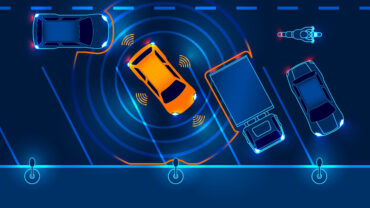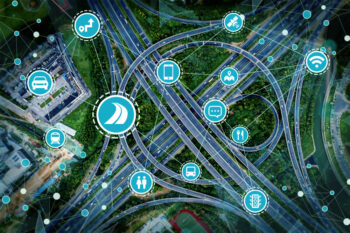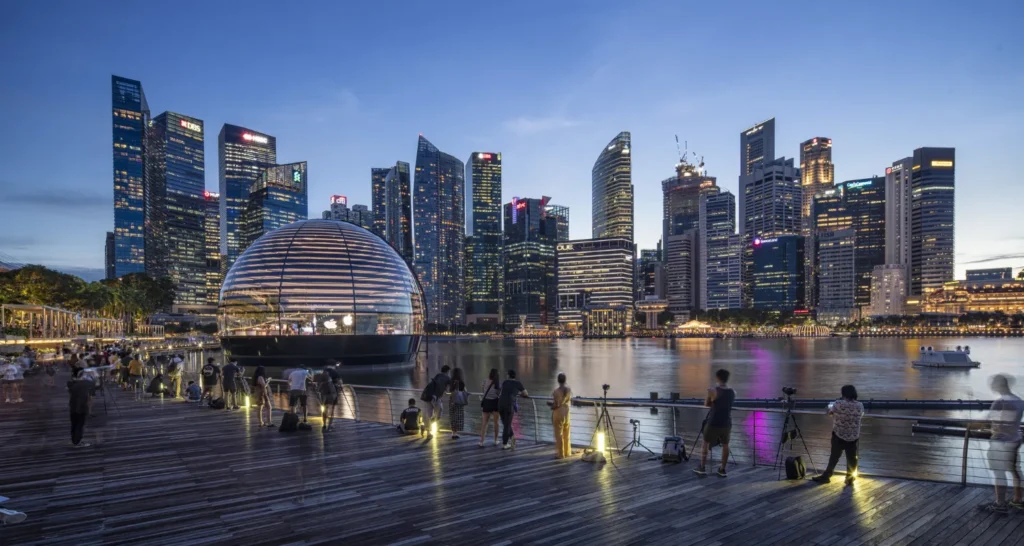Whilst almost two decades in IT, Roman has driven an extensive track of business and technology transformation projects for the US and Middle East clients. With strong technical background and product management skillset, Roman leads IT consulting, advisory practices, and large-scale projects for emerging and enterprise markets by delivering high-value services. Romans hands-on experience in shaping operational excellence to tackle business challenges helps tech innovators and Fortune 500 companies deliver excellent products and services for billions of users across the globe.
Roman Pavlyuk VP, Digital Services
1. During your Research & Development, have you discovered typical problems of cities or citizens, and have you located the solution to these
problems? How did you learn to integrate these technologies into cities, and what were city representatives and citizens?
Bringing all our experience together, we’ve set high standards of research and development that are now a part of our corporate culture. When starting any research, we prioritize user needs and problems as a part of a pragmatic framework in product engineering. So, let’s think about an average smart city end-user (which is any of us).
Which problems arise?
Suppose you miss an update about the roadworks on your regular route. Then you struggle to buy the correct fare for the replacement bus. It leaves without you. Uber asks for a surcharge because they can. Then you nearly get run over by a whizzing e-scooter as you decide to walk to your destination. A day like that makes anyone wonder: Where is all the glorified mobility as a service technology? And why is no one getting a finer grip on multimodal urban transportation planning?
First of all, you need to know how to navigate and find your way around the city. How do you buy a bus ticket? Which bus should you choose? Will your SIM card and bank card work? How should you park not get fined? I am quite well-traveled, and I must say these are the usual questions I ask myself every time I’m in a new city. Digital assistance systems might be a part of a solution here.
The second thing (directly connected to the first one), is our safety.
If you are not good at navigating around the city, you might risk taking the wrong direction, missing your station, or even getting into a dangerous area in the middle of the night with the next bus coming only tomorrow morning.
For citizens, it is also of utmost importance to feel safe around the city, both at home and outdoors. Offices, factories, administrative institutions, and all other forms of smart buildings need to be
protected against fire, natural calamities, and unauthorized entrance. Even in remote areas, buildings can be equipped with various sensors so that owners can keep control of deformation, temperature, etc.
And then, think about time and effort optimization. The modern world and modern societies require complex solutions that can address multiple large-scale challenges. If I plan my route around the city, I will avoid crossing the city six times here and there. It is neither eco-friendly nor economically viable. Traffic management systems today are under pressure to evolve and
become leaner, greener, and more connected. But what type of technology goes into designing such systems?
Then, of course, we are looking for efficient energy management for the smart buildings where we live and work.
For example, a few years ago, the Intellias team enhanced such a solution for a Belgian IWMS (integrated workplace management system) company. Together, we implemented software that helps Fortune -100 companies (over 1.5 million users total) save resources and act more sustainably. This software monitors over 50,000 data points per second, analyzes data and sends it to mobile apps.
Another enormous aspect we need to highlight is smart buildings and our desire to make them as user-friendly as possible. Building and facility automation comprises all the building’s critical systems such as lighting, climate control, fire alarms, security, and more. This is especially convenient for locations that are hard to reach. Instead of focusing on regular maintenance of expensive sensors, businesses can set up the infrastructure and focus their efforts and investments on business-critical tasks.
These problems are everywhere in the world: be it Kyiv, London, or Singapore.
2. How do you see the Citys improvement after implementing your projects/products into the city infrastructure? What are the expected results in the short (2030) and long (2050) term views?
A short-term goal is to narrow down the gap between urban and rural areas in their pursuit to turn into smart cities. Smaller cities suffer from insufficient resources, lacking know-how, rudimentary infrastructures, and missing funds to invest in smart city initiatives. However, larger cities can help them deliver smart services by sharing the knowledge and resources that their smaller counterparts otherwise couldn’t get access to. Regional collaboration enhances services like traffic congestion management, smart mobility, smart lighting, and smart grid energy.
By the way, energy use optimization is also something we will be able to address soon. In 20210, I was speaking at the Danish Intelligent Energy forum. It turns out Denmark has enriched 100% of the energy meters with smart technology. This brings both the user experience of residential users and energy-saving methods nationwide to a whole new level. I guess this is a successful case that other countries should and will re-use and apply in the short term.
From the mid-term perspective, I would prioritize solving the safety challenge. Here, I mean not only physical safety (like death threat), but also financial safety (if I use a parking meter in a new city and press some button, wouldn’t my money or data be stolen by scammers?).
Сomplex digital assistance systems integrated with international mobile banking apps would be a solution here. Although these systems combine many functions, they would be of much ease to use and onboard new users. Besides, smart city platforms would be able to identify tourists and newcomers to offer them seamless experiences and access to local services.
Smart cities also bring a huge difference to those who live in the area in the event of an emergency. This is another aspect of safety challenges we strive to resolve. Using opt-in data and reading the situation, governments can give people live updates on the status of an emergency, provide personalized instructions for evacuation, and rescue them if they happen to be unable to evacuate by themselves or go missing.
Of course, some cities will be able to implement these features sooner than others. In the long run, smart city platforms should become unified or standardized, so that one solution can work seamlessly globally, from Berlin to Dubai. They would include city infrastructure and navigation, access to emergency and city services, and information segmented by the user type: tourists, locals, newcomers, students, etc.
As of today, many cities are open to collaborating with private MaaS technology companies to create joint standards and improve data availability.
Lisbon, for example, is developing a shared Mobility Catalog of third-party tools for governing the city’s transportation and ensuring accurate information delivery by journey planners and transportation apps. Stepping it at this stage could be a win for both the city and the private provider.
For instance, we recently helped a German transportation company standardize data formats and build smooth data pipelines and routing for supplying real-time transit data to other companies. We also helped them launch several mobilities as a service platform feature. To sum up, the most obvious improvement will be the way cities, welcome people. We will always be
coming to cities that are happy to have us.
3. What are measurable criteria by which you track the performance of your solution? What do you measure, and what parameters do you evaluate? What is the monitoring period to decide whether the project is efficient?
The philosophy of smart cities lies in user comfort. They should not be built because “it is cool” or because “others do so” (although some governments might be following this logic, unfortunately). So the key criteria should be usability and timing, in particular.
How much time does it take to find a parking slot in a new city? A local restaurant chain? How quickly will you be able to plan the optimal route? If it takes you 5 minutes instead of an hour, it is a significant improvement.
So, the main KPI here is basically how quickly a user reaches the goal and it should be measured through surveys.
Another example. Some time ago, there were parking attendants in my hometown to assist me, so the whole parking and paying process would take me something like 10 minutes. Now I have a parking app integrated with the mobile banking system and it takes me nothing:
I park and then pay as I go. You can also read how the Intellias team has developed a smart parking system for a leading Dutch mapping company with the help of mobile-friendly maps.
4. What do you think? What is following what? Are people changing based on new technologies coming on the market? Or is it a technology that is changing based on people’s needs?
In the product management theory, people’s needs are primary, and technology follows. This is our primary guide at Intellias when developing new software solutions. At the same time, we should not forget it might be a rather spiral movement where stakes are growing all the time. No one can deny this is a continuous process of mutual exchange. Innovative technologies open up new layers of intelligence that will continuously learn, adapt, and respond to individual needs and consequently provide citizen-centered experiences and services. The more layers, the more opportunities for a city to behave and grow in a new way.
For example, back a few years ago, many public administrations launched initiatives to spread free Wi-Fi across the cities. However, as 5G and fast mobile internet connections evolved, these projects turned unpopular and needless. In this case, we started with the people’s need for seamless connections everywhere.
Simultaneously, we realized this is a chance to improve city transportation systems and we bring the live stream into the buses, with information about the current bus stop, weather, and time on a screen. Then we put a live bus schedule to each bus stop, and users enjoy the comfort they get. They want even more, like the same information and updates in the underground, for example.
Further, we see how faster connection can improve traffic monitoring, including city lights, CCTV, anomalies detection, traffic jams, etc. Instead of having one road camera for the intersection and formal tracking, we can put 12 cameras round-the-clock and watch various indicators live. In this case, the extra benefits that technology has brought gave rise to peoplespeople’sand opportunities.
By the way, at Intellias, we also worked on an IoT-enabled traffic management solution for one of our clients. The pilot system we designed aggregates data from in-car sensors, road cameras, public traffic feeds, and user devices. After being processed locally on the edge device, this information is dispatched to the cloud system for further analysis. Then it is made available to road users and regional traffic management centers as real-time updates on traffic conditions.
5. What inventions will change the world during the next 15 years? Have you read or seen some features that impressed you in the past few years?
The fact that we still receive information via five wits might turn out to be a challenge for us, a huge informational challenge for the whole of humanity. Moreover, we receive most information through hearing and seeing. No matter how well-developed the smart city platform will be, its usability (in particular, timing – something I have mentioned above) would depend on our natural ability to get new data.
In these terms, an invention that amazes me is Elon Musk’s Neuralink, though its widespread implementation might take more than 15 years. It might not seem directly connected to the smart city, but let me explain.
A Neuralink-like system will help us interact with the city faster than ever before, without active cognitive or conscious involvement.  To pay for the underground trip, I won’t need to use my bank card or a coin, the biometric system will identify me automatically at the entrance and write off the funds from my bank account. It’s a grab-and-go system similar to what Amazon implemented around five years ago: no lines, no checkouts. I know, it might sound scary or futuristic now, but to my genuine belief, this is where humanity is heading.
To pay for the underground trip, I won’t need to use my bank card or a coin, the biometric system will identify me automatically at the entrance and write off the funds from my bank account. It’s a grab-and-go system similar to what Amazon implemented around five years ago: no lines, no checkouts. I know, it might sound scary or futuristic now, but to my genuine belief, this is where humanity is heading.
Finally, let’s briefly mention a Berlin-based startup Lilium. This is a promising new urban mobility concept of air taxis. In the upcoming years, it can become an integral part of the transportation system in urban areas, tackling challenges with traffic jams, cost and space optimization, connections to rural areas, air pollution, and lethal incidents on the road.
Lilium or similar solutions will allow us to reinforce the sharing economy and use city resources more efficiently. It’s also a great chance for regular citizens to benefit from the mobility platforms integrated between public and private stakeholders. And I cannot wait to see this technology coming to the masses.
About the company:
Intellias is a global technology partner to Fortune 500 enterprises and top-tier organizations, helping them accelerate their pace of sustainable digitalization. With nearly two decades of experience, Intellias is geared towards ensuring the sustained success of our clients on their value journey. By delivering value to our partners and clients with the power of technology, we inspire confidence that their digital initiatives will succeed. They trust us with finding solutions to the toughest challenges and breaking constraints on their way to meaningful innovation in a dynamic market environment.
Intellias delivers custom software solutions that make cities more comfortable, sustainable, and secure. Also, our mobile development services help cities adapt to growing populations, overcome traffic congestion, and promote a sustainable future.
We help city administrations integrate new and legacy infrastructure into a holistic system, allowing for effective management of city operations and bringing visible improvement to people’s everyday lives. We know how to leverage cutting-edge technology to bring maximum value — whether it’s a safer, faster, and more efficient commute, self-sustaining energy management, public safety, connected infrastructure, or other solutions that enhance the quality of life of their citizens.













